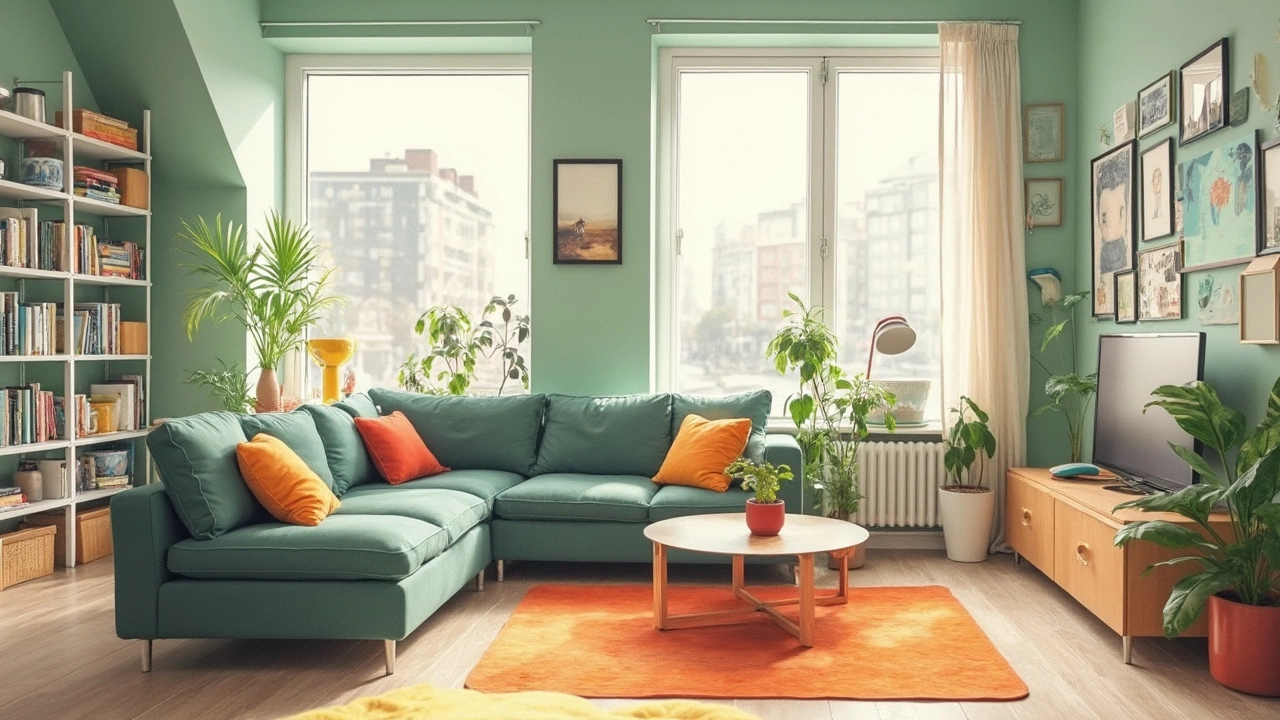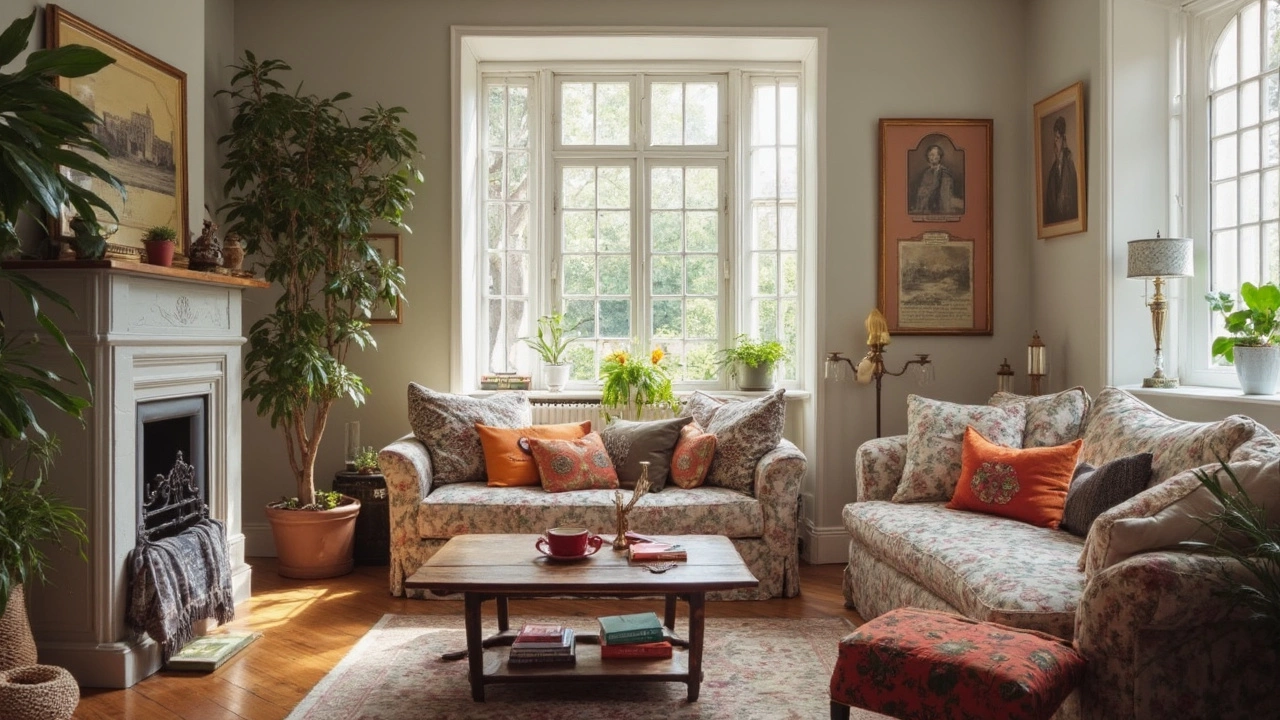Look at your living room right now. Chances are it could feel a whole lot better with just a few small moves. Before buying anything, start by clearing out stuff you don't use—like piles of magazines, lonely chairs, or weird dusty knick-knacks. Less clutter means more space for your favorite things to stand out.
Now, try shifting your furniture. Most people push everything against the walls, which looks stiff. Pull the couch in a little, angle a chair, and let your coffee table float in the middle—suddenly, the room feels friendlier and more put together. Think about how you use the space: do you love movie nights, or is chatting with guests more your thing? Arrange seats so it’s easy to kick back or have a good conversation.
- Declutter and Rearrange
- Add Color and Texture
- Lighting That Makes a Difference
- Accessories and Personal Touches
Declutter and Rearrange
Let’s get real—clutter is the #1 thing that makes any space look messy. In most homes, things just pile up: remotes on the coffee table, kids’ toys in the corner, stacks of papers that never seem to move. The honest truth? Just clearing these out can instantly make your living room feel bigger and more expensive. It’s not just about looks, either. According to research from the Princeton Neuroscience Institute, physical clutter actually affects how well you focus and process information. A tidy space really can clear your head.
Start with small sections instead of tackling the entire living room decor at once. Focus on the coffee table, end tables, shelves, or entertainment unit. Ask yourself: do I use this, love this, or even notice it anymore? If not, it’s time to let it go or stash it out of sight. Use baskets, trays, or hidden storage to keep the essentials, but get everything else gone.
- Collect all the things that don’t belong in the living room and move them out right away.
- Group similar items—like books or remote controls—so they look organized, not scattered.
- Use a mix of open shelves for things you love, but hide stuff you don’t use every day in boxes or baskets.
Once you’re down to the basics, let’s move stuff around. Most people never change their layout, but a simple switch can make the home styling feel brand new. Pull the sofa slightly off the wall. Rotate, swap, or angle chairs for a more natural look. Even shifting the rug or lamps can wake up a tired room. Try a few variations until it feels just right for your routine—Netflix binges, reading, or family game night.
Here’s a quick comparison of the most common living room layouts and what they’re good for:
| Layout Type | Best For |
|---|---|
| All furniture to walls | Big gatherings, open feel |
| Grouped around a rug | Cozy chats, movie watching |
| Angles and mixes | Showing off unique pieces |
Don’t be afraid to experiment. Snap a quick photo after you move things—sometimes that’s the easiest way to spot what still looks off. If you nail this part, you’ve already nailed half the battle of interior design and made room for every other finishing touch.
Add Color and Texture
Here's where you can really change your living room decor without dropping a fortune. Picking the right color can make a massive difference. No joke: even just switching up your throw pillows can make you love your couch again. According to Sherwin-Williams, blue and green are the most calming shades for common spaces, while yellows and warm tones bring in energy.
Layering is the trick that most interior designers use but hardly anyone actually talks about. Jarret Yoshida, a well-known New York designer, said it best:
"A single layer—like just painting the walls—is rarely enough. Texture and color together create interest and comfort."
If your space feels flat, it probably needs different textures. Try these easy fixes:
- Mix and match pillows with different fabrics—cotton, velvet, chunky knit.
- Lay down a rug, even over carpet. This zones your seating area and adds warmth.
- Toss a textured throw over your sofa. It’s both stylish and useful on chilly nights.
- Swap in curtains that add pattern or a color pop if your walls are plain.
Don’t stress about everything matching. A couple mismatched pieces can make the whole space feel more lived-in. Studies show people actually feel more comfortable in rooms where not every piece is perfectly coordinated.
If you want to keep things low-key, you don’t have to paint a whole wall. Accent pieces like bright vases, colorful art, or even an offbeat footstool can do the heavy lifting for you.
| Quick Color Wins | Effort |
|---|---|
| Swap pillow covers | 5 minutes |
| Add a bold rug | 10 minutes |
| Hang bright artwork | 15 minutes |
| Paint one accent wall | 1 hour |
The bottom line: a little color and texture go way further than most people think when upgrading your home styling or pulling off an easy makeover.

Lighting That Makes a Difference
If your living room still has just one ceiling bulb lighting up the whole space, it’s time for a change. Good lighting can seriously upgrade your living room decor and completely change the mood. Professionals say the trick is to layer your lighting—don’t rely on just one source.
For starters, bring in a mix of different lights. Use a main ceiling fixture for the basics, but add lamps at different levels. Try a floor lamp next to the couch, table lamps on side tables, and maybe even some wall sconces for extra warmth. This mix creates cozy spots and gets rid of darker corners.
You’ll want to use bulbs that give off a warm, inviting glow—somewhere around 2700K if you check the packages. Stay away from those cold, blue-toned lights; they make even great furniture and colors look kinda flat.
Want something that feels a bit fancier? String lights, LED strips behind your TV, or even a dimmer switch can make a huge difference without spending a ton of money. In fact, adding a dimmer switch is one of the cheapest ways to bring a living room from "meh" to "wow." As of 2023, about 43% of American households had installed at least one dimmer, up from 29% just five years before:
| Year | Homes with Dimmer Switches (%) |
|---|---|
| 2018 | 29 |
| 2020 | 36 |
| 2023 | 43 |
And don’t forget natural light. Pull back those heavy curtains during the day—more sunlight can make a small space feel a lot bigger and more welcoming. If your windows face an ugly view, hang sheer curtains for privacy but let the sunshine through.
- Layer your lighting: overhead, lamps, accent lights.
- Pick warm-toned bulbs (around 2700K).
- Add fun extras like dimmers, LED strips, or fairy lights.
- Maximize sunlight during the day with simple window treatments.
With a few tweaks, you’ll notice your living room decor looks totally different just from better lighting. Sometimes, it really is that simple.
Accessories and Personal Touches
Accessories are the simple way to show your style and make your living room feel like yours. Don’t be afraid to mix things up—decor isn’t a set-it-and-forget-it deal. Start with a base: a few good throw pillows, a textured blanket tossed over the sofa, and maybe a rug that ties the room together. Keep the colors and patterns connected in some way, even if it's just a thread of blue or a common texture. That’s a classic living room decor trick to keep things looking intentional.
Stack some coffee table books that match your interests—travel, art, whatever you’re into. They aren’t just for show: people love flipping through them. Add a candle or two (vanilla and sandalwood are safe picks) and a small plant for some green. NASA even claims houseplants like pothos or snake plant can improve air quality indoors, so you get bonus points for health. Here’s a quick guide on easy green options:
- Pothos – Almost impossible to kill, survives in low light
- Snake Plant – Needs water just once every week or two
- Spider Plant – Great for hanging baskets, very low maintenance
Family photos or artwork are a must for that personal touch. Instead of spreading pictures all over, try a photo gallery on one wall. Use matching frames or different sizes for a more relaxed look. Clusters look thoughtful, not accidental.
This isn’t just about looks—research by the Journal of Environmental Psychology found that people feel happier and more relaxed in spaces featuring personal mementos. So bust out those concert posters, travel souvenirs, or even your kid’s best doodle. Your stuff tells your story.
| Accessory Type | Impact |
|---|---|
| Pillows and Throws | Add comfort, color, and texture |
| Books and Candles | Start conversation and cozy vibes |
| Plants | Improve air and brighten up the room |
| Photos/Art | Show personality and create a "home" feel |
Don’t stress about getting everything right. Switch out accessories with the seasons or whenever you get bored. Little changes keep your home styling feeling fresh without much effort or cash.
